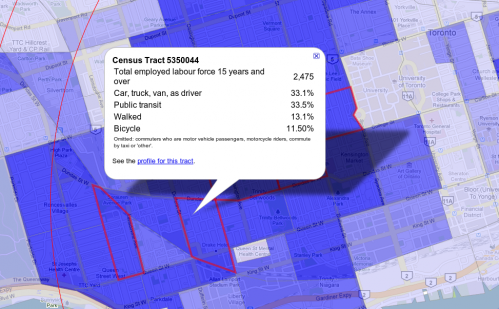(Photo: Toronto Star)
A nice article on Yvonne, bike union ED, and her take on winter riding by Catherine Porter of the Toronto Star. Apparently the key to winter cycling is tissues for the running nose (and a bicycle). The best part of this article is the pretentiousness and, yet, feminine angle. You don't need much more than a bicycle, a warm jacket and confidence to bike in the winter. If one day is too scary, wait until the snow clears up and you'll find it's quite refreshing:
We've met on a sunny morning and set off in search of winter's axis of evil: snow, slush and ice. Now that we've found it, Bambrick instructs me to push into it, slowly, but with confidence. "Don't lose your nerve."
Look at her: tall, long black coat, chic red hat dotted with a delicate bicycle pin, dark sunglasses. She could be shopping in Paris.
Her bike is a grey Dutch seven-speed, the front basket adorned with bulrushes, white plastic flowers cascading off the back.
How could you spout epithets from your car window at this woman? If the old cycling crowd is Kensington Market, Bambrick is Uptown. She is gentrifying the image of cycling in the city.
Her tool is the Toronto Cyclists Union. Bambrick, 33, is its executive director, her salary paid mostly through the dues of its 800 members, proof in itself of the rising class, and commitment, of cyclists.
....
Still, Bambrick is hardcore – she bikes year-round. To prove cycling is a legitimate form of transportation, you need to do it in winter – just like drivers do.
I am a fair-weather commuter. Come December, I hang up my clunker in the shed. I rode only once in the snow – on the back of a friend's bike during my first winter at McGill.
We crashed into a snowbank, my chauffeur laughing maniacally. It confirmed my suspicion that winter cyclists are nuts.
Who else would add black ice and skidding cars to the list of perils summer cyclists face?
"It's not for everyone," Bambrick concurs. "There's days when you shouldn't be driving a car either."
Her advice: Wear layers. And goggles. Slow down. Stay stable. Use "extreme caution" approaching streetcar tracks. Practice first.
She thinks it's so safe, she doesn't wear a helmet, which by law she doesn't have to.
I harden my resolve and pedal toward a mess of snow, slush and car treads. My tires slip. When I brake, my rear wheel slides.
"It takes about a month to get your winter legs," Bambrick says.
There is lots of advice out there, but you can forget most of it and get along quite well. The one thing you shouldn't forget is to approach icy, slippery surfaces carefully, taken them head on if you can't avoid them, and no sudden braking, turning or speeding up.
With that in mind you'll have an enjoyable time cycling this winter.



